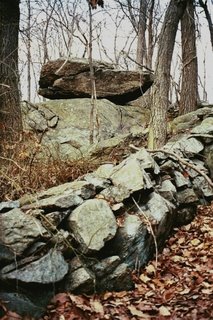Things can look like other things accidentally. One day our cat was playing with a string, and when she walked away, the string defined what would have been a perfect profile of a face. That's chance. It happens. Sometimes rocks look like things. When the likeness is very close, it can seem uncanny, more so to the minds of people who don't read written language. The kind of symbolic thinking required for literacy was originally projected on the world surrounding us. In a sense, ancient people 'read' the earth, living things, rocks and stars.
There's a lot to see at Oley Hills. Both times I was there, the distress caused by the disconnect between what I'd always known and what I was seeing had a strong effect on me. Berks County was where I had lived for most of my life, and to have Northampton County natives take me there and show me impossible things was a mind blower. So maybe that's why I experienced a state of uncertainty as to what was there and what I was projecting, what was real and what was not.

The perched stone above seemed pretty innocent. Yes, it kind of looked like a dog head, as someone pointed out, but its significance surely lay in its positioning and the way the wall led you to where you couldn't miss it.

The second time I went, I had my son with me. The first time I had spotted a boulder that looked like something, and I wanted to see what he thought. (I was afraid anyone else would think I was nuts). But on the way to the boulder, he stopped me to show me the stone in the picture above. It looks like a crow, he said.

We finally got to the boulder, and he said he, too, thought it looked like a duck head. This photo doesn't do it justice, but I used it because you can see the wall linkage to the left. In case you can't see the duck, his hand is just above the eye. For anyone who's curious, I have much better shots of it.
 He wandered off to be with the young child of someone else who was there, but I was seeing things in rocks wherever I went. The rock above looked like an old man with his eyes closed.
He wandered off to be with the young child of someone else who was there, but I was seeing things in rocks wherever I went. The rock above looked like an old man with his eyes closed.
The rocks in the picture above looked like a warrior to me. Was this some huge ancient gallery?

As we left, someone pointed out the above and said it looked like a turtle, but that didn't work for me. Still, although you can barely see it from this angle, a wall, interrupted by the modern road, runs right up to the formation.

And then, as it was getting dark, I passed this boulder. The picture is of poor quality because the light had grown dim, but to me this looked a lot like the turtles I'd played with as a child, only 20 miles away.
We can't know what the people who piled the rocks did and didn't see in the boulders around them. But one theory of why some stone sites around the world are where they are has to do with electromagnetic frequencies. While some scientists are attaching electrodes to the heads of meditating monks and measuring the frequencies of their brainwaves as they reach transcendent states, others are measuring low sound waves generated by the running of underground water and electromagnetic frequencies generated by minerals like magnetite.
Some claim to have found that at special sites the frequencies in the earth mimic those of the meditators, and may induce states in some people. For some time, thinkers like Paul Devereux have discussed the possibility that the landscape itself can in some cases be a hallucinogen or an entheogen. He cites the Australian aborigines' dreamtime as an example of the process in action.
Even here, a lot of people who've spent good amounts of time outdoors, especially as children, can relate an experience of epiphany or timelessness that, while our culture has no framework for it, is very much like what many other cultures would call a communication from spirits.
Things that have long been dismissed by Western civilization as pathetic fantasy may, in the decades to come, be found to have a scientific basis. I'm reminded of a conversation with a tribal elder that someone told me about. He said that in the old days, before cars and trucks and planes created vibrations and before radio and TV sent all these waves through the air, you could get, at certain places a feeling or vibration, maybe like electromagnetic frequencies, that made you feel a certain way. Some stone piles and walls were built to mark sites like that.
The rocks of the ridge on which Oley Hills is built are mostly gneiss, but within it there are pockets of magnetite. Does this have any bearing on the placement of the site, or on the readiness I experienced to see faces and creatures in stones? I don't know. While I like to hear theories and informed speculation, I'm not convinced until facts fall into place.
Sorry to take up so much room with this topic. The next and last Oley Hills section will be odds and ends photos and a short wrap-up.
No comments :
Post a Comment